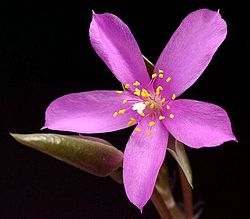アナカンプセロス科
| アナカンプセロス科 | ||||||||||||||||||
|---|---|---|---|---|---|---|---|---|---|---|---|---|---|---|---|---|---|---|
 アナカンプセロス・ルーフェセンス (Anacampseros rufescens) の花
| ||||||||||||||||||
| 分類 | ||||||||||||||||||
| ||||||||||||||||||
| 学名 | ||||||||||||||||||
| Anacampserotaceae Eggli & Nyffeler | ||||||||||||||||||
| 属 | ||||||||||||||||||
|
本文参照 |
アナカンプセロス科 (Anacampserotaceae) は、植物学の科学誌「 Taxon誌 」の2010年2月号で提案された被子植物のナデシコ目の科である。本科は、アフリカ、オーストラリア、アメリカに生息する3つの属と約40の多肉植物の種から構成されている。サボテン科とは近縁だとされる。
分類
[編集]本科は、ウルス・エッグリ (Urs Eggli) とレト・ニッフェラー (Reto Nyffeler) によるナデシコ目のスベリヒユ亜目 (Portulacineae)における多系統群の分析に基づいて提唱された。新しい科とその限界は、分子系統学及びその形態学的データに基づいている。その3つの属であるアナカンプセロス属 (Anacampseros) 、グラハミア属 (Grahamia) 、タリノプシス属 (Talinopsis) とそれらに含まれている(とその当時に分類されていた分の)計36種[1]については、かつてはスベリヒユ科に置かれていた[2][3]。本科は、APG植物分類体系の改訂版であるAPG IIIで承認されている[4]。
形態
[編集]本科の種は低木または厚い茎を持つ多年生の草本植物である。グラハミア属の茎には粘液が含まれている。種の中には幹の付け根や根の部位が厚くなって芋になっているものがある。螺旋状の多肉的な葉は円柱形に丸まるが、稀に平べったいものもある。葉腋には毛や小さい鱗片葉がつく[5]。
花茎の主軸の先端や腋に花が僅かにつく花序が特徴であり、しばしば節間を圧迫したり蝸牛状花序になったりするものもある。大変魅力をそそられるのは、小さいものから程よい(中間サイズの)大きさで咲く両性花についてである。がく片にある2枚の葉は多肉的で頑丈であるが、果実が生る時に干からびてしまう。花には5枚の花冠がある。5本から25本までの雄しべと、子房上位に3つの雌しべが合弁して心皮を構成している。 花被はひとつの薛(帽)を形成する。グラハミア属とタリノプシス属は丈夫な雄しべの集まりを、アナカンプセロス属は抜け落ちていって単一になってしまった雄しべの残りを花被の近くに付けている。
果実は蒴果であり、グラハミア属を除いて、もろくなった外果皮は内果皮から剥がれ落ちる。内果皮の先端部分は割れてバスケット状になる。通常は軽くて角張り大きくて白く色付いた種子が出来る。種皮は2層となっており、外側の種皮はほぼ完全に剥離する。エライオソームはあまり無い。
分布
[編集]本科は熱帯を中心に広大な地域に生息している。オーストラリアからアフリカ東部にかけてはアナカンプセロス属、更にはアメリカ大陸(アルゼンチン、ボリビア、メキシコ、米国)にはグラハミア属とタリノプシス属が分布している[5]。
系統
[編集]
| ||||||||||||||||||||||||||||||||||
主な属
[編集]- アナカンプセロス属 (Anacampseros)
- グラハミア属 (Grahamia)
- タリノプシス属 (Talinopsis)
画像
[編集]-
Anacampseros rufescens
-
Anacampseros alsonii
-
Anacampseros filamentosa
脚注
[編集]- ^ Christenhusz, M. J. M.; Byng, J. W. (2016). “The number of known plants species in the world and its annual increase”. Phytotaxa (Magnolia Press) 261 (3): 201–217. doi:10.11646/phytotaxa.261.3.1.
- ^ Nyffeler, R., and U. Eggli. 2010. Disintegrating Portulacaceae: A new familial classification of the suborder Portulacineae (Caryophyllales) based on molecular and morphological data. Taxon, 59(1): 227-240.
- ^ "Anacampserotaceae Eggli & Nyffeler". Germplasm Resources Information Network (GRIN). Agricultural Research Service (ARS), United States Department of Agriculture (USDA). 2010年3月18日閲覧。
- ^ Chase, M. W., and J. L. Reveal. 2009. A phylogenetic classification of the land plants to accompany APG III. Botanical Journal of the Linnean Society, 161(2): 122–127. doi:10.1111/j.1095-8339.2009.01002.x
- ^ a b Reto Nyffeler, Urs Eggli: Disintegrating Portulacaceae: A new familial classification of the suborder Portulacineae (Caryophyllales) based on molecular and morphological data. In: Taxon. Band 59, Nummer 1, 2010, S. 227–240.
Text is available under the CC BY-SA 4.0 license; additional terms may apply.
Images, videos and audio are available under their respective licenses.



